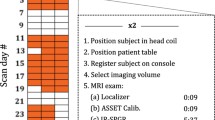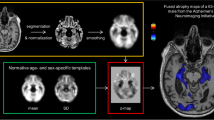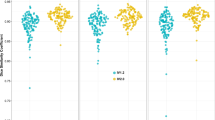Abstract
The cortical thickness has been used as a biomarker to assess different cerebral conditions and to detect alterations in the cortical mantle. In this work, we compare methods from the FreeSurfer software, the Computational Anatomy Toolbox (CAT12), a Laplacian approach and a new method here proposed, based on the Euclidean Distance Transform (EDT), and its corresponding computational phantom designed to validate the calculation algorithm. At region of interest (ROI) level, within- and inter-method comparisons were carried out with a test–retest analysis, in a subset comprising 21 healthy subjects taken from the Multi-Modal MRI Reproducibility Resource (MMRR) dataset. From the Minimal Interval Resonance Imaging in Alzheimer’s Disease (MIRIAD) data, classification methods were compared in their performance to detect cortical thickness differences between 23 healthy controls (HC) and 45 subjects with Alzheimer’s disease (AD). The validation of the proposed EDT-based method showed a more accurate and precise distance measurement as voxel resolution increased. For the within-method comparisons, mean test–retest measures (percentages differences/intraclass correlation/Pearson correlation) were similar for FreeSurfer (1.80%/0.90/0.95), CAT12 (1.91%/0.83/0.91), Laplacian (1.27%/0.89/0.95) and EDT (2.20%/0.88/0.94). Inter-method correlations showed moderate to strong values (R > 0.77) and, in the AD comparison study, all methods were able to detect cortical alterations between groups. Surface- and voxel-based methods have advantages and drawbacks regarding computational demands and measurement precision, while thickness definition was mainly associated to the cortical thickness absolute differences among methods. However, for each method, measurements were reliable, followed similar trends along the cortex and allowed detection of cortical atrophies between HC and patients with AD.





Similar content being viewed by others
Data Availability
Data used in the preparation of this article were obtained from the public MIRIAD database (https://www.ucl.ac.uk/drc/research/methods/minimal-interval-resonance-imaging-alzheimers-disease-miriad) And the Multi-Modal MRI Reproducibility Resource at (https://www.nitrc.org/projects/multimodal).
References
Ashburner J (2007) A fast diffeomorphic image registration algorithm. Neuroimage 38(1):95–113
Blustajn J, Krystal S, Taussig D, Ferrand-Sorbets S, Dorfmüller G, Fohlen M (2019) Optimizing the detection of subtle insular lesions on MRI when insular epilepsy is suspected. Am J Neurordiol 40(9):1581–1585
Cardinale F, Chinnici G, Bramerio M, Mai B, Sartori I, Cossu M, Lo Russo G, Castana L, Colombo N, Caborni C, De Momi E, Ferrigno G (2014) Validation of FreeSurfer-estimated brain cortical thickness: comparison with histologic measurements. Neuroinformatics 12(4):535–542
Clarkson MJ, Cardoso MJ, Ridgeway GR, Modat M, Leung KK, Rohrer JD, Fox NC, Ourselin S (2011) A comparison of voxel and surface based cortical thickness estimation methods. Neuroimage 57(3):856–865
Dahnke R, Yotter RA, Gaser C (2013) Cortical thickness and central surface estimation. Neuroimage 65:336–348
Dale AM, Fischl B, Sereno MI (1999) Cortical surface-based analysis I. Segmentation and surface reconstruction. Neuroimage 9(2):179–194
Das SR, Avants BB, Grossman M, Gee JC (2009) Registration based cortical thickness measurement. Neuroimage 45(3):867–879
Desikan RS, Ségonne F, Fischl B, Quinn BT, Dickerson BC, Blacker D, Buckner RL, Dale AM, Maguire RP, Hyman BT, Albert MS, Killiany RJ (2006) An automated labeling system for subdividing the human cerebral cortex on MRI scans into gyral based regions of interest. Neuroimage 31(3):968–980
Fischl B, Dale AM (2000) Measuring the thickness of the human cerebral cortex from magnetic resonance images. Proc Natl Acad Sci USA 97(20):11050–11055
Fischl B, Liu A, Dale AM (2001) Automated manifold surgery: Constructing geometrically accurate and topologically correct models of the human cerebral cortex. IEEE Trans Med Imaging 20(1):70–80
Fischl B, Salat DH, van der Kouwe AJW, Makris N, Ségonne F, Quinn BT, Dale AM (2004) Sequence-independent segmentation of magnetic resonance images. Neuroimage 23:S69-84
Han X, Jovicich J, Salat D, van der Kouwe A, Quinn B, Czanner S, Busa E, Pacheco J, Albert M, Killiany R, Maguire P, Rosas D, Makris N, Dale AM, Dickerson B, Fischl B (2006) Reliability of MRI-derived measurements of human cerebral cortical thickness: the effects of field strength, scanner upgrade and manufacturer. Neuroimage 32(1):180–194
Hutton C, De Vita E, Ashburner J, Deichmann R, Turner R (2008) Voxel-based cortical thickness measurements in MRI. Neuroimage 40(4):1701–1710
Hutton C, Draganski B, Ashburner J, Weiskopf N (2009) A comparison between voxel-based cortical thickness and voxel-based morphometry in normal aging. Neuroimage 48(2–8):371–380
Jones SE, Buchbinder BR, Aharon I (2000) Three-dimensional mapping of cortical thickness using Laplace’s equation. Hum Brain Mapp 11(1):12–32
Landman BA, Huang AJ, Gifford A, Vikram DS, Lim IAL, Farrell JAD, Bogovic JA, Hua J, Chen M, Jarso S, Smith SA, Joel S, Mori S, Pekar JJ, Barker PB, Prince JL, van Zijl PCM (2011) Multi-parametric neuroimaging reproducibility: a 3-T resource study. Neuroimage 54(4):2854–2866
Li Q, Pardoe H, Lichter R, Werden E, Raffelt A, Cumming T, Brodtmann A (2015) Cortical thickness estimation in longitudinal stroke studies: a comparison of 3 measurement methods. NeuroImage Clin 8:526–535
Lüsebrink F, Wollrab A, Speck O (2013) Cortical thickness determination of the human brain using high resolution 3 T and 7 T MRI data. Neuroimage 70:122–131
Malone IB, Cash D, Ridgway GR, MacManus DG, Ourselin S, Fox NC, Schott JM (2013) MIRIAD-Public release of a multiple time point Alzheimer’s MR imaging dataset. Neuroimage 70:33–36
Marquez J, Bloch I, Bousquet T, Schmitt T, Grangeat C (2005) Shape-based averaging for craniofacial anthropometry (abstract). In: IEEE sixth Mexican international conference on computer science, pp 314–319
Mateos MJ, Gastelum-Strozzi A, Barrios FA, Bribiesca E, Alcauter S, Marquez-Flores JA (2020) A novel voxel-based method to estimate the cortical sulci width and its application to compare patients with Alzheimer’s disease to controls. Neuroimage 207:116343
Price CC, Wood MF, Leonard CM, Towler S, Ward J, Montijo H, Kellison I, Bowers D, Monk T, Newcomer JC, Schmalfuss I (2011) Entorhinal cortex volume in older adults: reliability and validity considerations for three published measurement protocols. J Int Neuropsychol Soc 16(5):846–855
Righart R, Schmidt P, Dahnke R, Biberacher V, Beer A, Buck B, Hemmer B, Kirschke JS, Zimmer C, Gaser C, Mühlau M (2017) Volume versus surface-based cortical thickness measurements: A comparison study with healthy controls and multiple sclerosis patients. PLoS One 12(7):e0179590
Rosas HD, Liu AK, Hersch S, Glessner M, Ferrante RJ, Salat DH, van der Kouwe A, Jenkins BG, Dale AM, Fischl B (2002) Regional and progressive thinning of the cortical ribbon in Huntington’s disease. Neurology 58(5):695–701
Salat DH, Buckner RL, Snyder AZ, Greve DN, Desikan RSR, Busa E, Morris JC, Dale AM, Fischl B (2004) Thinning of the cerebral cortex in aging. Cereb Cortex 14(7):721–730
Ségonne F, Dale AM, Busa E, Glessner M, Salat D, Hahn HK, Fischl B (2004) A hybrid approach to the skull-stripping problem in MRI. Neuroimage 22(3):1060–1075
Seiger R, Ganger S, Kranz GS, Hahn A, Lanzenberger R (2018) Cortical thickness estimation of FreeSurfer and the CAT12 toolbox in patients with Alzheimer’s disease and healthy controls. J Neuroimaging 28(5):515–523
Talairach J, Tournoux P (1988) Coplanar stereotaxic atlas of the human brain. Thieme Medical Publishers, New York
Yotter RA, Dahnke R, Thompson PM, Gaser C (2011a) Topological correction of brain surface meshes using spherical harmonics. Hum Brain Mapp 32(7):1109–1124
Yotter RA, Thompson PM, Gaser C (2011b) Algorithm to improve the reparameterization of spherical mappings of brain surface meshes. J Neuroimaging 21(2):e134-147
Acknowledgements
This work was supported by grant number 479002, and registration number 629404, from CONACYT (Consejo Nacional de Ciencia y Tecnología, Mexico), for a Master’s in Science in Medical Physics at the UNAM. Data used in the preparation of this article were obtained from the MIRIAD database. We are also grateful to M.Sc. L. González-Santos for technical support and J. González-Norris for editing of the manuscript. The MIRIAD investigators did not participate in analysis or writing of this report. The MIRIAD dataset is made available through the support of the UK Alzheimer’s Society (Grant RF116).
Funding
The original data collection was funded through an unrestricted educational grant from GlaxoSmithKline (Grant 6GKC) and funding from the UK Alzheimer’s Society and the Medical Research Council. Also receives funding from the EPSRC (EP/H046410/1) and the Comprehensive Biomedical Research Centre (CBRC) Strategic Investment Award (Ref. 168). And support by the Medical Research Council (grant number MR/J014257/1). This work was supported by the National Institute for Health Research (NIHR) Biomedical Research Unit in Dementia based at University College London Hospitals (UCLH), University College London (UCL). The Multi-Modal MRI Reproducibility Resource (MMRR) dataset received funding from NIH/NCRR P41RR15241 NIH/NINDS 1R01NS056307. The MIRIAD or MMMRIRR investigators did not participate in analysis or writing of this report.
Author information
Authors and Affiliations
Corresponding authors
Ethics declarations
Conflict of Interest
The authors declare that they have no conflict of interest.
Ethics Approval
All studies counted with authorization of their IRB.
Informed consent
All authors have read and consented to the submission of the final version of the manuscript to the journal.
Additional information
Handling Editor: Irena Rektorova.
Publisher's Note
Springer Nature remains neutral with regard to jurisdictional claims in published maps and institutional affiliations.
Rights and permissions
About this article
Cite this article
Velázquez, J., Mateos, J., Pasaye, E.H. et al. Cortical Thickness Estimation: A Comparison of FreeSurfer and Three Voxel-Based Methods in a Test–Retest Analysis and a Clinical Application. Brain Topogr 34, 430–441 (2021). https://doi.org/10.1007/s10548-021-00852-2
Received:
Accepted:
Published:
Issue Date:
DOI: https://doi.org/10.1007/s10548-021-00852-2




